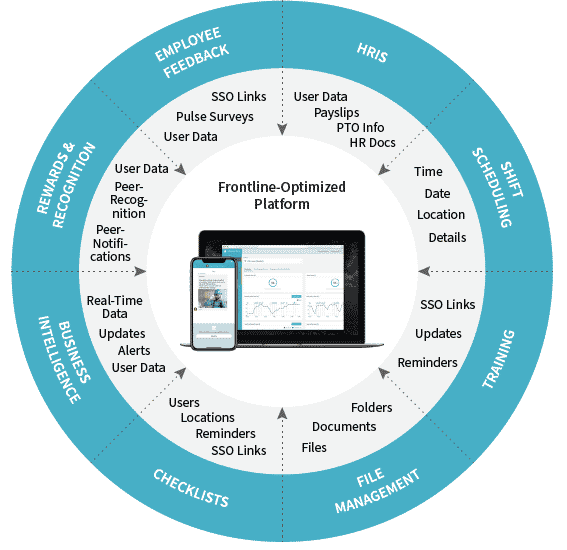FFOW Part 1 | Who Are Frontline Workers?

As the contributions of essential workers continue to be recognized and celebrated by the public, we thought it was time to take an in-depth look at who these frontline workers are, what they need, and what the future of work looks like for them. So, we’ve set out to create a 5-part blog series called Frontline Future of Work (FFOW). This article, “The Reality of Being a Frontline Worker: Who Are They and What Do They Need?” is part one. Stay tuned for more!
Every business is, at its core, a people business. One would be hard-pressed to find a business that doesn’t serve the interests of someone, in some way. Sure, we’ve all heard “truisms” like “money makes the world go ’round,” but who makes and spends the money that keeps it spinning? People, at every level, are at the heart of every enterprise and what makes business happen. Everyone is necessary and is part of an interconnected and interdependent web of effort.
All too often, however, the contributions of those whose efforts drive the economy from the frontlines are ill-equipped and under-supported when it comes to providing for their safety, health, and well-being during this unprecedented time.
Questions organizations need to ask themselves and credibly answer are as simple as: “Who are our frontline workers?” and as complex as “How do we help them equitably and sustainably?” and “How can we harness established and emerging platforms to ensure both their safety and success with respect and dignity?”
What Does the Term ‘Frontline Worker’ Mean?
Though it may seem easy to identify who a frontline worker might be, it’s important to define our terms. Extrapolating from definitions provided by the Department of Homeland Security definitions and data from the Bureau of Labor Statistics, the Brookings Institution, reports
“We have found 50 million people who qualify as frontline workers—a majority of the 90 million people employed in America’s essential industries.”

Predictably, during a pandemic, those essential industries include healthcare and public health according to the Department of Homeland Security. Others include first responders in public safety and law enforcement, as well as the food and agriculture industries. Energy, water, transportation and logistics, and public works are also deemed essential as are communications and information technology sectors.
Rounding out the list are the critical manufacturing, hazardous materials industries, financial services, chemical workers, and the defense industrial base — industries that support the needs of the military.
In their recent profile of frontline workers in New York City, the city comptroller clustered the aforementioned industries more tightly, breaking them down as follows:
- Grocery, Convenience, and Drug Stores
- General merchandise stores
- Public Transit; Trucking, Warehouse, and Postal Service
- Building Cleaning Services
- Health Care
- Child Care and Social Services
Prior to the COVID-19 pandemic, it was estimated that there were more than 30 million U.S. workers employed in these six essential industries. “They include grocery store clerks, nurses, cleaners, warehouse workers, and bus drivers, among others. They were essential before the pandemic hit, yet also overworked, underpaid, under-protected, and underappreciated,” reads a report entitled A Basic Demographic Profile of Workers in Frontline Industries created by the Washington, DC-based Center for Economic and Policy Research (CEPR).
On a more granular level, however, frontline workers represent an array of people who share similarities when it comes to their demographic makeup. The study found that characteristically, frontline workers earn lower wages, tend to have less access to education, and over a third of them are over 50. Among all frontline workers, one-in-six “live with someone who is (or are themselves) over age 65,” says the CEPR report, which also puts them at higher risk of death if they contract the coronavirus.
Like the general population, about half of all frontline workers are women. However, when it comes to essential frontline workers, over 64% are women, according to the CEPR. Moreover, they’re overrepresented in the two industries that represent our most fragile populations — patients in a healthcare environment and those in childcare and social services at nearly 77% and over 85% respectively.
Moreover, African Americans are likewise overrepresented when it comes to providing childcare and social services (just over 19% of workers identify as Black in this industry). They’re also often the most susceptible to economic crises.
It’s not difficult to see that frontline workers — those keeping the business world functioning at its person-to-person level — are among the most vulnerable people on the planet right now.
Yet, day after day, beneath their masks, they put on a brave face and continue providing the services the nation needs to sustain itself and its people. How are they rewarded? All too often with inadequate support and safety measures, not to mention chronically low wages and the looming threat of losing those wages in the event that they are unable to work.
Frontline Workers Deserve Better, But Where Do We Start?
Though Congress recently passed a bevy of COVID-19 legislation, including various protections, frontline workers still remain both woefully underprotected and under compensated. CEPR offers an array of recommendations that are sweeping and long overdue.
These recommendations include action on a variety of fronts to ensure that all frontline workers have:
- Comprehensive health insurance that includes free coverage of COVID-19 testing and treatment
- Paid sick leave and paid family leave
- Free child care
- Student loan relief
- Consumer and labor protections, including hazard pay or other additional compensation for essential workers
To that end, CEPR also recommends that frontline workers who are also immigrants receive protection regardless of their current immigrant status. Similarly, CEPR calls for the US Occupational Safety and Health Administration to issue an Emergency Temporary Standard that requires employers to provide “specific and necessary protections for frontline workers.”
What it comes down to is that frontline and essential workers deserve better. They need to be supported in doing the work that supports entire nations. Where many companies can start is through implementing better technology and tools to enable their essential workers on the digital front. To that end, Beekeeper has invested tremendous effort and resources into creating a program to digitally enable our frontline workforces.

According to a recent Harvard Business Review report, 87% of survey respondents expressed that when their workers are empowered to make important decisions in the moment, their organization is inherently more successful.
With real-time information easily and readily accessible via a digital communications platform, frontline employees can effectively make decisions reflective of the organization’s policies, procedures and increasingly, its data.
Digital Enablement for Frontline Workers Is the Future (Because It’s Already the Present)
This year, mobile device usage experienced a 70% global spike and with that came a similar spike in the amount of mobile app spending. Currently 96% of young workers in the United States are smartphone owners and among those, for 22% these devices are their only means of accessing the Internet. Given this relative surge in mobile connectivity, the place for integrating a unified communications platform is already in your workers’ pockets.
Sandra Goger, a workplace collaboration expert at global software development company Itransition says,
“Today frontline workers typically use the same enterprise-wide collaboration tools as other types of employees. However, the specifics of the frontline work and the required speed of their communication will be the driving force in how frontline collaboration tools evolve.”
Frontline-centric collaboration tools should be developed for mobile-first use, Goger argues with the added provision that frontline workers should always have the opportunity to access the full gamut of collaboration tools using corporate or personal mobile devices.

“That’s why desktop-only portals aren’t the option for modern businesses,” says Goger, who adds, “Collaboration tools should become smart enough to turn collaborative content generated daily into a reusable asset. Customer case studies, service updates, and shared documents should be easily searchable in collaboration threads. At a more advanced level, employees should get purposeful content in a form of suggestions generated automatically and depending on a current collaboration context.”
Provided they have a digital strategy, businesses that can rapidly deploy communication tools and enable immediate access to necessary information will be best able to adapt to and overcome the challenges of the day.
Moreover, occupations that require interacting and intersecting with the public-at-large, especially in this present — and often fraught — moment, should not only use unified communication platforms to empower employees to make decisions but also ensure their safety while preserving their inherent right to dignity in the workplace as well. This is not a tall order — it’s the right thing to do especially in the face of new challenges that frontline workers probably never thought they would face.
The New Not-So-Normal
We’ve all seen the viral videos in which an irate customer publicly chastises a customer service representative for some grievance. They are often difficult to watch. Throughout these viral videos runs a common theme: that of a frontline worker who is dutifully and patiently informing customers of and enforcing a company policy.
These incidents serve as harrowing reminders that the pandemic and socio-political turmoil that is defining this era have left some psychically frayed and unable to maintain their sense of civility at a moment in time when society needs it most.
“An employer needs to demonstrate that they are willing to defend an employee when dealing with an irrationally hostile customer,” says Jeff Neal who runs The Critter Depot, a dropshipping business that specializes in providing live crickets, roaches, and worms as food for pet reptiles . Even Neal’s entirely online enterprise has seen an uptick in customers behaving badly.
“The customer isn’t always right, and should not feel prompted to verbally attack a customer service representative,” says Neal who adds that online customer services representatives, though not in physical danger are often subject to mental and emotional abuse by some customers. “We are seeing it first-hand that customers, who are new to the nuances of shopping online, lose patience quickly with our staff, and turn into hostile, unpleasant customers.”
No matter what the situation, communication is key. While cities try to flatten the COVID curve in their municipalities, organizations should strive to flatten their communication curves by reevaluating antiquated communication hierarchies and creating, in their place, a free-flowing communication network to those who need it, when they need it.
Many agree that committing to a single, unified communications platform benefits frontline workers the most. Carla Diaz, co-founder of Broadband Search, a tool to find broadband providers in one’s area, agrees that using a unified communication and collaborations platform creates a more streamlined experience for employees and allows them to discuss projects and work together in a centralized location.
“It’s just a better system for running business operations and ensures staff understand one another better,” says Diaz. “I expect that these tools will continue to be some of the most important aspects of running a remote business long into the future.”
Change Is Good…and Now It’s Also Necessary
As Kane Carpenter sagely observes,
“Most companies will have been in the midst of some form of digital transformation over the last few years, but the ‘new normal’ as a result of factors such as COVID-19 means that the future has been brought forward by a decade or two.”
Carpenter is the director of career services at Daggerfinn, a national strategic employer branding consultancy. He’s seen, firsthand, the need for companies to push their unified communications strategies forward…and fast.
“Organizations that were planning on standing up communication and collaboration tools in the next few years now realize that there is an immediate need for these capabilities – and will have to invest in moving quickly or else they will lose their standing in their respective industries,” says Carpenter.
Accomplishing this isn’t just the right thing to do — it can also provide a competitive advantage that will help your organization thrive in the ever-shifting business environment.
“From an employer branding perspective, you can see a world where the best talent will be attracted to organizations that have the strongest mix of collaboration and communication tools as these features will set them up for success,” says Carpenter.
“It is a good strategy then for organizations to highlight the initiatives and programs they have in place with regard to communication and collaboration, and build this into their overarching employer branding strategy.”
Ultimately, frontline employees are not only the public-facing employees of a business, they also guide the customer journey. They are the faces of our businesses, as well as their backbone, and deserve to be given the tools to succeed.
“Frontline workers are the ones who work out of their comfort zones and face the dangers of coronavirus just to keep the operations smooth-flowing. Companies must invest in proper tools that can make frontline work easy and safe.”
– Vipin Chahal, founder of Return Policy Guide, an online site that helps customers easily locate and compare return and refund policies of world’s leading brands.
“The frontline workers who are braving the pandemic must be saluted for the commendable effort they have been putting in.”
Want to build the frontline workforce of the future? Download our Frontline Future of Work eBook.
About the author
Cristian Grossmann
CEO and Co-Founder, Beekeeper
Cris is CEO and Co-Founder of Beekeeper, an award-winning digital workplace app that digitizes the non-desk workforce in 137+ countries by connecting operational systems and communication channels within one intuitive platform. Beekeeper helps companies increase performance and productivity, enhance employee engagement, reduce turnover costs, and elevate corporate culture. Prior to founding Beekeeper, Cris worked for Accenture on high profile international projects in the field of IT Strategy for the financial and public sectors. Cris studied Chemical Engineering and got his Ph.D. in Electrical Engineering, both at ETH Zurich. Before moving to beautiful Zurich, Cris was born and raised in an entrepreneurial Swiss-Mexican family in Mexico City.
Interested in learning more?
Join 1200+ companies transforming frontline work with Beekeeper. Start your journey today to make every task easier, every team stronger, and every shift smoother.







